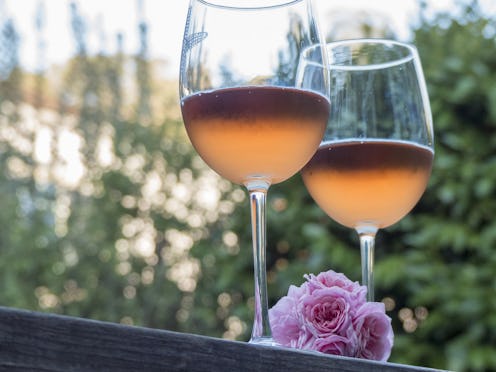
A rose by any other name would smell as sweet, argues Juliet of Romeo’s Montague parentage. But what about rosé?
Rosé has been the beverage of peak summertime for the past few years: with its millennial pink maceration, its singular drinkability, so-called summer water is really, really difficult not to love. So it’s understandable that rosé-flavored drinks are seeking to capitalize on rosé’s unparalleled excellence. We now live in an era of rosé gummies, rosé marshmallows, rosé vodka, and now, rosé hard cider — the alleged drink of summer 2018. But in an age of unparalleled rosé abundance, I ask: why can’t we just let rosé be rosé?
It’s not like we can’t enjoy rosé (the wine) in its different iterations. Last summer saw the rise of frosé, the delightful, boozy, wine and fruit slushy sipped everywhere from urbane rooftop bars to countryside garden parties. On a recent press trip through Napa Valley, I found myself sampling canned rosés at the garden restaurant of the Culinary Institute of America at Copia — sacrilegious to the orthodox, but within the inviolable compound of the CIA? Extremely refreshing. Rosé is an incredibly diverse type of wine: you can get light rosé, dark rosé, natural rosé, rosado, rosato, cans, bottles, boxes. Whatever. So what’s the deal with all the non-rosé rosés out there?
The issue is that at its core, rosé is wine. Not vodka, not hard cider, not marshmallows — wine. It is the product of crushed grapes, a few hours of skin contact, and dreams. So when a product comes along with r-o-s-é spelled out on its label, it’s misleading, for one — like when vegan alternatives are marked “meatballs” or “cheese,” something that doesn’t contain wine can’t quite call itself rosé. (To be fair, some of these rosé-flavored things *do* contain some rosé, but the experience is generally far removed from that of drinking wine.) Rosé’s meteoric rise in popularity has also led to the name’s conflation with all things pink, and with millennial pink’s influence over almost all design staying strong for the third straight year, it’s understandable why some rosé-adjacent products might seek to benefit from that association.
Moreover, some people might not want to drink rosé as it was intended — hence, these products’ filling a void in the market. “I love rosé, but it’s a little dry for me,” says my colleague Emma Lord, who covers trending food news. She likes these non-rosé options because of her “huge” sweet tooth, and likens it to tasting the “full scope of the human experience.”
“We make flavored versions of other things all the time,” she says. By my logic, “anything flavored shouldn’t exist, because it didn’t exist like that originally.” Fair. And admittedly, there are some inarguably positive applications of this flavor profile: products like Welch’s $4 non-alcoholic rosé make the experience of summer water more accessible for people who can’t or don’t drink alcohol, for example, and you’d be hard pressed to legitimately critique a rosé macaron.
But Lord also acknowledges that non-rosé commodities hiding behind a rosé-colored façade is “gimmicky.” And that, I think, underscores my complaint with these not-quite-rosé foods, beverages, hairstyles, or whatever other noun the internet seeks to push viral as we head into rosé season, formerly known as summer. When actual rosé has never before been so accessible, so omnipresent, why do we feel the need to cheapen that experience — one that takes winemakers years to learn how to master — by lumping every other pink thing on the internet in with what some say may be the oldest wine variety in the world? Just say they’re pink marshmallows!!
Rosé sales were up 53 percent by volume in 2017, according to Forbes, so the trend clearly isn’t going away anytime soon. But when anything can call itself rosé, is anything actually rosé? That's why, this summer, I'll be squarely in the corner of the party, avoiding all things rosé-flavored — with a glass of (actual) rosé in my hand.